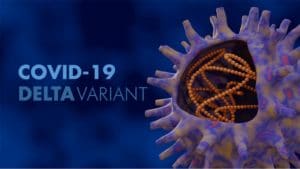Unless you are a super parent, you are no doubt right now scrambling to gather school supplies, back packs, that lunch box that Tommy
just loves, and ma ybe a pair of shorts or two that don’t have mystery stains on them from something in the cafeteria last school year. As we look toward schools starting in the next week or so (and a few that already have….sorry), many of you are being faced with several new questions and circumstances surrounding the SARS-CoV-2 delta variant, the vaccines available, and how to best keep your loved ones safe. Hopefully this little blurb from us here at Pediatric Associates will help to fill in some of those blanks. If you’re scrolling down and don’t have the time to read the entirety of the blog, here is a quick video summary.
ybe a pair of shorts or two that don’t have mystery stains on them from something in the cafeteria last school year. As we look toward schools starting in the next week or so (and a few that already have….sorry), many of you are being faced with several new questions and circumstances surrounding the SARS-CoV-2 delta variant, the vaccines available, and how to best keep your loved ones safe. Hopefully this little blurb from us here at Pediatric Associates will help to fill in some of those blanks. If you’re scrolling down and don’t have the time to read the entirety of the blog, here is a quick video summary.
The Delta Variant
As you are now well aware, the delta variant is surging. Yes, it’s true. Yes, we’re really tired of this too….and we have to swim in it every single day. So what’s the bad news?
- Delta is 200% more transmissible, so we are likely to continue to see more kids getting it, especially after they start school and are all around one another again. Yes, we’re already seeing cases in our patients go up here in Abilene, and while kids are still doing well, comparatively speaking, we are seeing more admissions and have seen some become quite ill.

- Delta has a 1000% higher viral load, which means kids will test positive more quickly following exposure. This also means people are shedding more virus, so if your child comes in contact with a +COVID-19 case, the probability of getting infected increases (back to point 1).
- Last week, pediatric cases rose 84% in the US.
- The US is now again averaging over 100,000 new cases per day.
- Vaccination rates remain low in many states, including ours.
- Children are beginning to be hospitalized at higher rates than we have seen to this point in the pandemic, and pediatric critical care units are already near or at capacity due to the ongoing surge in respiratory viruses such as RSV that we have unseasonably seen this summer.
- COVID-19 vaccines for children under 12 years of age will likely not be approved until late fall or early winter.
- Coronaviruses are traditionally “winter viruses,” meaning they tend to circulate more easily during the colder months…which are coming.
Then what’s the good news?
- See vaccine section
COVID-19 Vaccines
As a reminder, there are currently 3 vaccines being widely used in the US. Two of them (Pfizer and Moderna) are mRNA vaccines and the Johnson and Johnson is a viral vector vaccine. Here’s some information on how these different types of vaccines work, and because we’re a little nerdy, here is a great video on how the mRNA vaccines work.
Currently the only vaccine with approval for children down to age 12 years is the Pfizer mRNA vaccine. The Moderna vaccine will likely be available for this age group before long. As of today, Moderna and Johnson and Johnson are available for those 18 years and up.
We understand that there has been a lot of “chatter” around these vaccines since they started being given in December of 2020 here in Abilene. Here is the long and short of it. THEY WORK. Period. End of story. The mRNA vaccines have been proven to be particularly effective against the variants that we are seeing, including delta. Currently, 90% of patients admitted to the hospital with COVID-19 are not vaccinated, and 94% of the patients admitted to the ICU with COVID-19 are not vaccinated. Roughly 99.5% of the individuals dying from COVID-19 currently are unvaccinated.
“See, I told you the vaccines aren’t working! Cases are on the rise and 90% and 94% means that some people are still getting admitted and even put in the ICU who were vaccinated.”
Thanks for that comment. However, no vaccine is perfect. Ever. In the history of vaccines. Remember, the vaccine studies’ endpoints were not whether or not people get COVID-19. It was whether or not you get severe or critical/mortal illness from COVID-19. So, technically, a “breakthrough case” is only defined as those fully vaccinated who are severely or critically ill or who die. This number is INCREDIBLY LOW, especially considering the sheer number of COVID-19 cases that remain out there. For comparison, the flu vaccine most years performs at around 50%. These vaccines are working. They are saving lives. End of story.
COVID-19 Vaccines and Kids
We stand in solidarity in recommending that those children who are eligible receive the vaccine as soon as possible. Here is the American Academy of Pedatrics policy statement on COVID-19 vaccines in children and adolescents.
As previously stated, currently the Pfizer mRNA vaccine is the only one authorized for use in kids between the ages of 12 years and 16 years. Moderna’s vaccine will likely follow suit soon for the same age group and at this time we are not expecting them to be authorized for younger children until late fall or early winter. Yes, this has us a bit concerned.
So what about all the scary side effects?
As parents ourselves, we understand concerns that are out there surrounding some of the things that have been in the media over the summer. Let’s dive into this.
- Every single human being who is not vaccinated will eventually get infected with COVID-19 in some variant form or another.
- There is nothing that we do in medicine that does not come with some risk for adverse effects. However, risk/benefit is always considered.
- It is now apparent that 1/20,000 children/young adults may experience myocarditis (inflammation of the heart) associated with the mRNA vaccine.
- This appears to be short lived and self resolving in the vast majority of cases, making it mild myocarditis (yes, we understand that sounds like a contradiction of terms).
- Most cases are occurring in male adolescents and young adults aged 16 years or older.
- This appears to be an effect of cytokine release which is similar to the inflammation seen in muscles (myositis) with some influenza cases.
- In studies of college aged individuals with natural COVID-19 infection, some form of myocarditis appears to occur 2.5% of the time. That would be 500/20,000.
- In those children that have gone on to develop MIS-C (multisystem inflammatory syndrome in children), 50-75% have developed myocarditis. We have seen roughly 4,000 cases of MIS-C in the US and, yes, several of those have been here in Abilene. Likely, a fair number of these cases will go on to develop long haul COVID and have symptoms for months.
- 1.3% of children diagnosed with COVID-19 have needed hospital admission since the beginning of the pandemic (this number is rising slowly with delta) and 0.01% of children who have been diagnosed with COVID-19 have died.
- Roughly 400 children have died from COVID-19 or MIS-C since the beginning of the pandemic. As a comparison, typically 75-150 children die each year from influenza. This is not the flu.

So in conclusion: NATURAL INFECTION CARRIES SIGNIFICANTLY MORE RISK THAN VACCINATION. 0.005% of children may get myocarditis with the vaccine that is TREATABLE or SELF RESOLVES the vast majority of the time. No children have died from this adverse effect. 0.01% of children who get COVID-19 naturally may die, and a significantly larger portion (2.5%) may develop the very myocarditis that you are trying to avoid in your child by choosing not to have them vaccinated.
And the M-word? (…..you know, masks….)
Gosh we are sure tired of them too. Remember, we’ve been wearing them at work…every day…since March of 2020. Our faces are tired and can get a little dry in places, but our ears aren’t starting to look funny, we’re not retaining CO2 leading to poor clinical decisions, and those of us with asthma aren’t having more issues than before. Dr. McClatchy’s make-up does get smeared, but other than that we’re pretty good. An no, we don’t want to wear them. We don’t enjoy it either. But given the rising number of cases, we do want to protect our patients who cannot be protected with vaccination at this point
Debates will continue on and science will continue to work through just how well masks work and just how much SARS-CoV-2 is transmitted via aerosolized or droplet spread, but the majority of students currently are unable to be vaccinated and masks have proven to be beneficial. This is also why we are recommending that students wear masks to school this Fall as well as practice social distancing and good hand hygiene, especially until case numbers start to slow again. Again, risk/benefit. The answer seems pretty clear.
We are also again asking that when coming to the office you and your loved ones wear a mask. If not for yourself, then please, for the infant or immunocompromised child or the pregnant mother you may encounter while you’re here. After all, we’re all in this together. Even if we land on different sides of certain issues.
As always, thank you for the opportunity to care for your children. We are grateful. Please contact us with any questions as we continue to move through this together.
Pediatric Associates